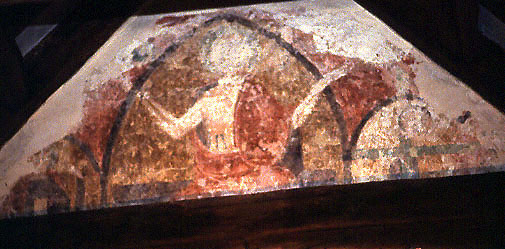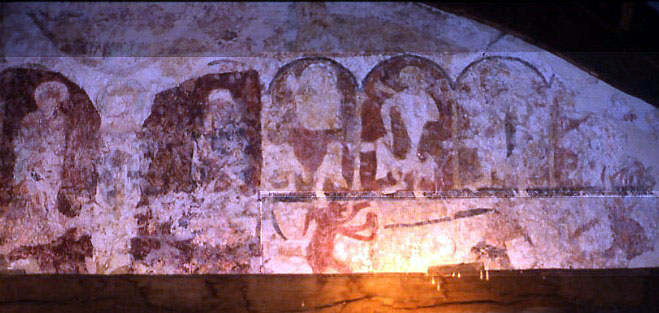Ashampstead, Berkshire (†Oxford) C.13
Doom

Stylistically, this is a decidedly transitional Doom, sharing some aspects of its iconography with the the early chancel paintings at Kempley, and others with much later paintings of the subject.
Beams with a plaster infill, rather than an arch, separate nave and chancel in the late 12th century church at Ashampstead, and the plaster provides the ground for the painting, much as it does at Marton. Framed in a mandorla, Christ, his robe open to show his wounds, sits not on a rainbow, but on something resembling a bench-like throne. Under individual round arches on either side of him angels hold Instruments of the Passion.
Below, between the upper and lower horizontals of the timber framework, and in the centre of the painting, the Crucifixion, with Mary and John, has been painted over whatever Judgement details were there originally (photo above right, detail, left). It can seem convincingly contemporary at first glance, placed as it is directly below the mandorla in which Christ sits, but it is a much later addition, possibly as late as the late 14th or early 15th century in date.

Only the right hand or south side is shown in the detail here at the (the left-hand side is well-nigh impossible to photograph clearly). The space here is divided into two tiers, and in the upper, a row of Apostles sits in attendance (matched by a corresponding row on the left). Only a few of them are even partly clear now, but the two nearest the centre show reasonably well here. The formal, hieratic articulation of them in their spaces recalls Kempley rather than anywhere else.
That is not true, though, of the lower of the tiers in this subdivided space on the right. Here, below the seated Apostles, the Saved and the Damned are going their separate ways. The left side of this bottom tier is barely visible at all now, and is not shown here, but according to Tristram’s drawing¹ it once showed angels, possibly with the Virgin Mary, and groups of figures – one hunched and naked group at the extreme left being effectively pushed out of the picture by an angel.
At the right (lowest tier, photograph above, right of centre), a red devil has, I think, taken over the pushing. Shown between him and another devil to the right is a rope or chain, on which the second devil hauls. Between the two is space which would probably once have been filled by a group of unfortunates being dragged away to Hell. Tristram suggested that the faint shape in faded red ochre at the extreme right might be the jaws of Hell, and if this is so, then the painting has much in common not only with Kempley’s early Byzantinesque Christ in Majesty, but also with Dooms of two centuries later.
The fine 13th century Annunciation and Visitation and the Nativity/Annunciation to the Shepherds are now on the site, which means that apart from a rather battered St Christopher, all the paintings at Ashampstead are now here.
Website for St Clement’s, Ashampstead
¹ Tristram II, p.502-503 & Plate 74